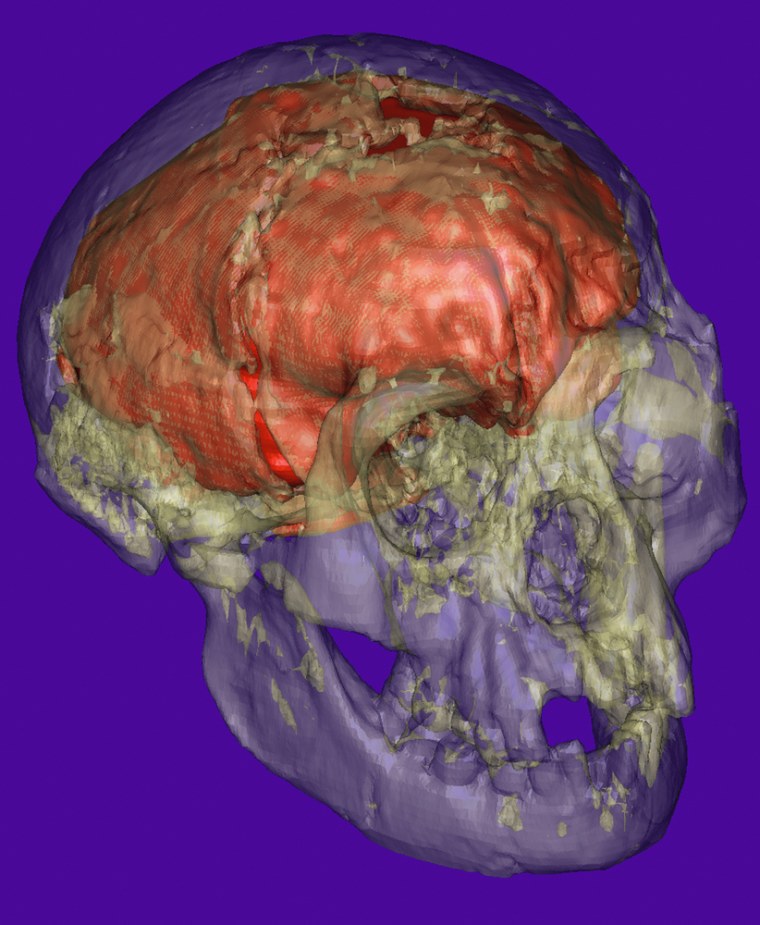Scientists working with powerful imaging computers say the spectacular “Hobbit” fossil recently discovered in Indonesia had distinctive brain features that could justify its classification as a separate — and tiny — human ancestor.
The new report, published Thursday in the online version of the journal Science, seems to support the idea of a human dwarf species marooned for eons while modern humans spread across the planet. Detractors of the theory, however, said the computer models were unconvincing.
The new research produced a computer-generated model that compared surface impressions on the inside of the fossil skull with brain casts of modern and ancient humans, as well as chimps and other primates. The scientists said the model shows that the 3-foot (1-meter) specimen, nicknamed Hobbit, had a brain unlike anything they had seen before in recent human lineage. The brain is chimplike in size, between 380 and 420 cubic centimeters.
Despite being up to two-thirds smaller than a modern human brain, the Hobbit fossil’s brain shared wrinkled surface features with the brains of both modern humans and Homo erectus, tool-making human ancestors that lived more than 1 million years ago, the researchers said. Some of those features are consistent with higher cognitive traits, they report.
At the same time, they said the Hobbit brain was different from the brain of a modern human pygmy or a human with abnormal brain growth.
“This is something new,” said Florida State University anthropologist Dean Falk, who led the study. “This discovery has flummoxed the field of anthropology.”
In October, scientists from Indonesia and Australia caused an international sensation with their report of a trove of fossils found in a cave on the equatorial island of Flores. As many as seven tiny individuals were represented by the bones in layers that were dated from 95,000 to 12,000 years ago. The Hobbit skeleton was the most complete specimen to be described.
Comparing cranium sizes
Falk and researchers from Washington University in St. Louis took three-dimensional CT scans of the interior of the Hobbit’s skull. Known as virtual endocasts, these computer-manipulated images show the wrinkles, vessels and other surface features that made faint impressions on the skull’s lining.
They compared that model with latex casts of the brains of chimps, a female Homo erectus, a contemporary woman, a pygmy and a European specimen of a person with a small-brain syndrome known as microcephaly.
Scientists say its brain shape reflects some features of modern humans, such as an expanded temporal lobe in the front and a fissure near the back of the brain known as the lunate sulcus, similarly found in the modern human brain.
The bones found in the cave were accompanied by sophisticated tools and evidence of firepits, suggesting an organized society of tiny hunters that flourished on the island for millennia at a time when modern humans dominated the planet.
Sparking a debate
Other human evolution specialists were split over the new report.
Katerina Semendeferi of the University of California-San Diego described it as a “cutting edge study.” While the Hobbit brain does not fit neatly into an evolutionary pattern, she said it is too much to expect that all ancient humans would have brains that would neatly transition from ape to modern human.
“There is increasing evidence that white matter and interconnectivity may be a critical component of human cognitive abilities,” she said.
But some other researchers dismissed the brain-scan study as “trivial.” They are sticking to their opinion that the Hobbit probably suffered from a form of microcephaly, a condition in which the brain fails to grow at a normal rate, resulting in a small head with a large face, and even dwarfism.
What it is not, says primatologist Robert Martin, provost of the Field Museum in Chicago, is a scaled-down version of a Homo erectus or a new transitional species that held on for millennia in tropical isolation.
That’s because Homo erectus had a brain size of more than 1,000 cubic centimeters, nearly as large as modern humans. Brain size cannot simply be scaled down to fit a body size, he said.
